


Latin America's IT
Challenges and Opportunities: IoE and IoT
By: Douglas LeeNo longer just “Playing in a Theatre Near You”, the Internet of Things (IoT) is the concept defining the digital inter-connection of everyday objects such as lighting systems, security systems, refrigerators, thermostats and smart devices, with additional embedded electronics, software and sensors. IoT allows those objects to be monitored and managed remotely over existing networks. The Internet of Everything (IoE) refers to a world where everything – people, processes, factories and objects are interconnected to add business value like never before. A few examples of IoE include transportation control systems, modernized electric grids, and automated production floors. Cisco’s “Digital Transformation with the Internet of Everything” indexes 100 examples of the digital transformations involving IoE. Both IoT and IoE have the potential to transform a country’s entire infrastructure, for example, to more efficiently operate their transportations systems within large cities and their energy systems (electric grids as well as new sources of renewable energy). Countries also have the possibility to transform many other industries such as manufacturing, banking, retail and even their government agencies for the benefit of their citizens and the global competitiveness of the country at large. Some countries in Latin America such as Brazil, Argentina, and Mexico, have historically benefited from leapfrogging to the latest technological breakthroughs. For example, by providing fast internet access, adopting 3G/4G networks and widely using Smart Phones some countries skipped over intermediate technologies like slower internet access, slower analog and 2G wireless networks, and voice-only cell phones. Given today’s global competitiveness challenge faced across Latin America’s industries, embracing IoT and IoE could be the catalyst to once again leapfrog the competition. According to an article entitled “Why Latin America Should Embrace the Internet of Things” by Alexis Raymond, over 99% of the physical objects that someday may be part of IoE are still unconnected. She cites Cisco’s prediction that of $19 trillion of potential value at stake over the next decade, close to $1 trillion corresponds to Latin America. And although IoT and IoE may lead to opportunities for companies and governments to embrace, there are still other challenges in the region such as increasing broadband penetration and modernizing existing network infrastructure. To support the needs of industries and governments, IoT and IoE devices and networks are going to need to be reliable and secure. Due to the vast number of devices and their dynamic nature, this is going to create operational challenges that scale well beyond those of today’s data networks. These challenges themselves are opportunities which SOPRIS and Zenoss are pursuing via the partnership that will help customers across Latin America build the foundation for unified IoT and a comprehensive IoE. SOPRIS and Zenoss have a number of customer opportunities underway throughout Latin America covering several of the sectors noted above (e.g. national electric grids modernizing to smart technology, national/global transportation logistics companies seeking to leverage Zenoss’ open and flexible architecture to create highly customized monitoring applications in public safety, manufacturing, mining, banking, telecommunications, etc.). It is exciting for SOPRIS and Zenoss to be engaged in such market dynamics across the Latin American region.

Today's Open Thread:
How Secure Is Your Favorite Messaging App?
By: Douglas LeeNo longer just “Playing in a Theatre Near You”, the Internet of Things (IoT) is the concept defining the digital inter-connection of everyday objects such as lighting systems, security systems, refrigerators, thermostats and smart devices, with additional embedded electronics, software and sensors. IoT allows those objects to be monitored and managed remotely over existing networks. The Internet of Everything (IoE) refers to a world where everything – people, processes, factories and objects are interconnected to add business value like never before. A few examples of IoE include transportation control systems, modernized electric grids, and automated production floors. Cisco’s “Digital Transformation with the Internet of Everything” indexes 100 examples of the digital transformations involving IoE. Both IoT and IoE have the potential to transform a country’s entire infrastructure, for example, to more efficiently operate their transportations systems within large cities and their energy systems (electric grids as well as new sources of renewable energy). Countries also have the possibility to transform many other industries such as manufacturing, banking, retail and even their government agencies for the benefit of their citizens and the global competitiveness of the country at large. Some countries in Latin America such as Brazil, Argentina, and Mexico, have historically benefited from leapfrogging to the latest technological breakthroughs. For example, by providing fast internet access, adopting 3G/4G networks and widely using Smart Phones some countries skipped over intermediate technologies like slower internet access, slower analog and 2G wireless networks, and voice-only cell phones. Given today’s global competitiveness challenge faced across Latin America’s industries, embracing IoT and IoE could be the catalyst to once again leapfrog the competition. According to an article entitled “Why Latin America Should Embrace the Internet of Things” by Alexis Raymond, over 99% of the physical objects that someday may be part of IoE are still unconnected. She cites Cisco’s prediction that of $19 trillion of potential value at stake over the next decade, close to $1 trillion corresponds to Latin America. And although IoT and IoE may lead to opportunities for companies and governments to embrace, there are still other challenges in the region such as increasing broadband penetration and modernizing existing network infrastructure. To support the needs of industries and governments, IoT and IoE devices and networks are going to need to be reliable and secure. Due to the vast number of devices and their dynamic nature, this is going to create operational challenges that scale well beyond those of today’s data networks. These challenges themselves are opportunities which SOPRIS and Zenoss are pursuing via the partnership that will help customers across Latin America build the foundation for unified IoT and a comprehensive IoE. SOPRIS and Zenoss have a number of customer opportunities underway throughout Latin America covering several of the sectors noted above (e.g. national electric grids modernizing to smart technology, national/global transportation logistics companies seeking to leverage Zenoss’ open and flexible architecture to create highly customized monitoring applications in public safety, manufacturing, mining, banking, telecommunications, etc.). It is exciting for SOPRIS and Zenoss to be engaged in such market dynamics across the Latin American region.

Open Thread:
How Should Brands Respond to #GamerGate Complaints?
By: Douglas LeeNo longer just “Playing in a Theatre Near You”, the Internet of Things (IoT) is the concept defining the digital inter-connection of everyday objects such as lighting systems, security systems, refrigerators, thermostats and smart devices, with additional embedded electronics, software and sensors. IoT allows those objects to be monitored and managed remotely over existing networks. The Internet of Everything (IoE) refers to a world where everything – people, processes, factories and objects are interconnected to add business value like never before. A few examples of IoE include transportation control systems, modernized electric grids, and automated production floors. Cisco’s “Digital Transformation with the Internet of Everything” indexes 100 examples of the digital transformations involving IoE. Both IoT and IoE have the potential to transform a country’s entire infrastructure, for example, to more efficiently operate their transportations systems within large cities and their energy systems (electric grids as well as new sources of renewable energy). Countries also have the possibility to transform many other industries such as manufacturing, banking, retail and even their government agencies for the benefit of their citizens and the global competitiveness of the country at large. Some countries in Latin America such as Brazil, Argentina, and Mexico, have historically benefited from leapfrogging to the latest technological breakthroughs. For example, by providing fast internet access, adopting 3G/4G networks and widely using Smart Phones some countries skipped over intermediate technologies like slower internet access, slower analog and 2G wireless networks, and voice-only cell phones. Given today’s global competitiveness challenge faced across Latin America’s industries, embracing IoT and IoE could be the catalyst to once again leapfrog the competition. According to an article entitled “Why Latin America Should Embrace the Internet of Things” by Alexis Raymond, over 99% of the physical objects that someday may be part of IoE are still unconnected. She cites Cisco’s prediction that of $19 trillion of potential value at stake over the next decade, close to $1 trillion corresponds to Latin America. And although IoT and IoE may lead to opportunities for companies and governments to embrace, there are still other challenges in the region such as increasing broadband penetration and modernizing existing network infrastructure. To support the needs of industries and governments, IoT and IoE devices and networks are going to need to be reliable and secure. Due to the vast number of devices and their dynamic nature, this is going to create operational challenges that scale well beyond those of today’s data networks. These challenges themselves are opportunities which SOPRIS and Zenoss are pursuing via the partnership that will help customers across Latin America build the foundation for unified IoT and a comprehensive IoE. SOPRIS and Zenoss have a number of customer opportunities underway throughout Latin America covering several of the sectors noted above (e.g. national electric grids modernizing to smart technology, national/global transportation logistics companies seeking to leverage Zenoss’ open and flexible architecture to create highly customized monitoring applications in public safety, manufacturing, mining, banking, telecommunications, etc.). It is exciting for SOPRIS and Zenoss to be engaged in such market dynamics across the Latin American region.
- 1
Contact Us
We engineer and execute cloud-based solutions for our clients. Contact our team to learn how we can start your business transformation today.



